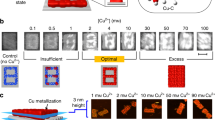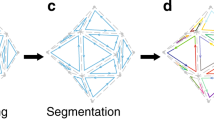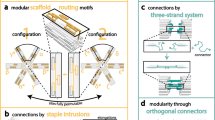Abstract
DNA origami have the potential to serve as self-assembling circuit boards for nanoelectronic devices. This paper focuses on understanding just one aspect of the hierarchical self-assembly of DNA origami—the oligomerization of individual origami to form chains of aligned and oriented origami. The eventual goal is to place small numbers of nanomagnets in specific locations on the DNA origami in such a way that the self-assembly of the origami causes a magnetic cellular automaton device, such as a wire, to be formed. Four strategies for forming well ordered chains of DNA origami were compared by examination of AFM images of DNA origami chains deposited on mica. Preliminary results of patterned deposition of DNA origami on lithographic patterns are also reported.
Access this chapter
Tax calculation will be finalised at checkout
Purchases are for personal use only
Preview
Unable to display preview. Download preview PDF.
Similar content being viewed by others
References
Kim, S.O., Solak, H.H., Stoykovich, M.P., Ferrier, N.J., de Pablo, J.J., Nealey, P.F.: Epitaxial self-assembly of block copolymers on lithographically defined nanopatterned substrates. Nature 424(6947), 411–414 (2003)
Tougaw, P.D., Lent, C.S.: Logical Devices Implemented Using Quantum Cellular Automata. Journal of Applied Physics 75, 1818 (1994)
Lent, C.S., Tougaw, P.D.: A Device Architecture for Computing with Quantum Dots. Proceedings of the IEEE 85, 541 (1997)
Lieberman, M., Chellamma, S., Varughese, B., Wang, Y., Lent, C., Bernstein, G.H., Snider, G., Peiris, F.C.: Quantum-dot cellular automata at a molecular scale. Annals of the New York Academy of Science 960, 225–239 (2002)
Niemier, M.T.: The Effects of a New Technology on the Design, Organization and Architectures of Computing Systems. U. of Notre Dame, Ph.D. Dissertation
Niemier, M.T., Kogge, P.M.: Exploring and exploiting wire-level pipelining in emerging technologies. In: Proceedings of the 28th annual international symposium on Computer Architecture, Göteborg, Sweden, pp. 166–177. ACM Press, New York (2001)
Cowburn, R., Welland, M.: Room temperature magnetic quantum cellular automata. Science 287, 1466 (2000)
Orlov, A., Imre, A., Ji, L., Csaba, G., Porod, W., Bernstein, G.H.: Magnetic Quantum-dot Cellular Automata: Recent Developments and Prospects. J. Nanoelec. Optoelec. 3(1), 55–68 (2008)
Chaudhary, A., Chen, D.Z., Whitton, K., Niemier, M., Ravichandran, R.: International Conference on Computer Aided Design Proceedings of the 2005 IEEE/ACM International Conference on Computer-Aided Design, San Jose, CA, pp. 565–571 (2005)
Niemier, M.T., Alam, M.T., Hu, X.S., Bernstein, G.H., Porod, W., Putney, M., DeAngelis, J.: Clocking Structures and Power Analysis for Nanomagnet-based Logic Devices. In: Proceedings of International Symposium on Low Power Electronics and Design, pp. 26–31 (2007)
Imre, A.: Experimental Study of Nanomagnets for Magnetic QCA Logic Applications. U. of Notre Dame, Ph.D. Dissertation
Imre, A., et al.: Majority logic gate for Magnetic Quantum-Dot Cellular Automata. Science 311(5758), 205–208 (2006)
Winfree, E., Liu, F., Wenzler, L.A., Seeman, N.C.: Nature 394, 539–541 (1998); He, Y., Chen, Y., Liu, H., Ribbe, A.E., Mao, C.: J. Am. Chem. Soc. 127, 12202–12203 (2005)
Barish, R.D., Schulman, R., Rothemund, P.W.K., Winfree, E.: An information-bearing seed for nucleating algorithmic self-assembly. PNAS 106, 6054–6059 (2009)
Han, S.-P., Maune, H., Barish, R., Bockrath, M., Goddard III, W., Rothemund, P., Winfree, E.: Self-Assembly of Carbon Nanotube Devices Directed by 2D DNA Nanostructures. Presented at Foundations of Nanoscience, Snowbird, Utah (April 2009)
Deng, Z.X., Mao, C.D.: DNA-templated fabrication of 1D parallel and 2D crossed metallic nanowire arrays. Nano Lett. 3, 1545–1548 (2003)
He, Y., Ko, S.H., Tian, Y., Ribbe, A.E., Mao, C.D.: Complexity emerges from lattice overlapping: Implications for nanopatterning. Small 4, 1329–1331 (2008)
Sharma, J., Chhabra, R., Cheng, A., Brownell, J., Liu, Y., Yan, H.: Control of Self-Assembly of DNA Tubules Through Integration of Gold Nanoparticles. Science 323, 112–116 (2009)
Yan, H., LaBean, T.H., Feng, L., Reif, J.H.: Directed Nucleation Assembly of Barcode Patterned DNA Lattices. PNAS 100, 8103–8108 (2003)
Rothemund, P.W.: Proceedings of the 2005 IEEE/ACM International Conference on Computer-Aided Design, San Jose, CA, November 6-10, pp. 471-478. IEEE Computer Society, Washington (2005)
Rothemund, P.W.K.: Nature 440, 297–302 (2006)
Horcas, I., Fernandez, R., Gomez-Rodriguez, J.M., Colchero, J., Gomez-Herrero, J., Baro, A.M.: Review of Scientific Instruments. 78, 013705 (2007)
Walter, H.: Ultrahigh resolution electron beam lithography for molecular electronics, Department of Electrical Engineering, University of Notre Dame, PhD thesis (2004)
Bernstein, G.H., Hill, D.A., Liu, W.P.: New high-contrast developers for PMMA resist. J. Appl. Phys. 71, 4066–4075 (1992)
Ke, Y., Linsday, S., Chang, Y., Liu, Y., Yan, H.: Science 319, 180–183 (2009)
Sarveswaran, K., Hu, W., Huber, P.W., Bernstein, G.H., Lieberman, M.: Langmuir 22, 11279–11283 (2006)
Niemier, M., Crocker, M., Hu, S., Lieberman, M.: Proceedings of International Conference on CAD (ICCAD), pp. 907–914 (2006)
Author information
Authors and Affiliations
Editor information
Editors and Affiliations
Rights and permissions
Copyright information
© 2010 Springer-Verlag Berlin Heidelberg
About this paper
Cite this paper
Kim, K.N., Sarveswaran, K., Mark, L., Lieberman, M. (2010). DNA Origami as Self-assembling Circuit Boards. In: Calude, C.S., Hagiya, M., Morita, K., Rozenberg, G., Timmis, J. (eds) Unconventional Computation. UC 2010. Lecture Notes in Computer Science, vol 6079. Springer, Berlin, Heidelberg. https://doi.org/10.1007/978-3-642-13523-1_9
Download citation
DOI: https://doi.org/10.1007/978-3-642-13523-1_9
Publisher Name: Springer, Berlin, Heidelberg
Print ISBN: 978-3-642-13522-4
Online ISBN: 978-3-642-13523-1
eBook Packages: Computer ScienceComputer Science (R0)




